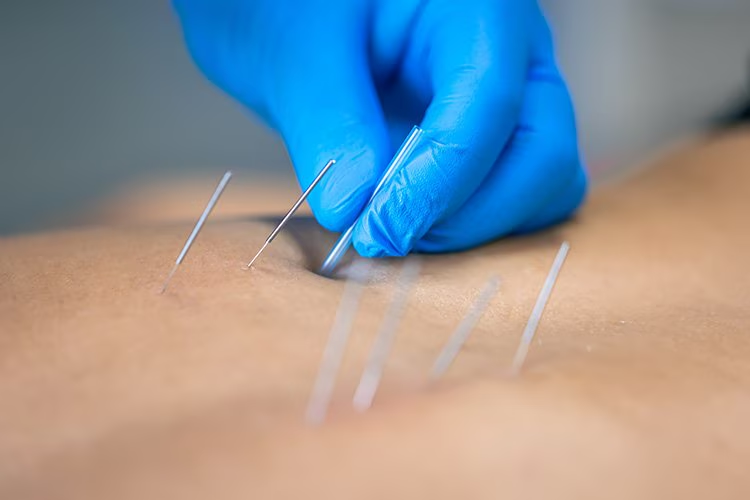
Dry Needling for Postpartum Pain & C-Section Scars | Pelvic Floor PT
Can dry needling help with postpartum pelvic pain and C-section scars?

If you're dealing with stubborn discomfort after giving birth—especially around a C-section scar, in your hips, or during sex—you've probably tried stretching, rest, and hoping it gets better on its own. Dry needling is one evidence-based tool we use in pelvic floor physical therapy clinics to address myofascial pain and scar restrictions that don't respond to other treatments alone. Here's what the research says, when it's safe, and how it fits into a complete postpartum rehab plan.
What the evidence says
Dry needling uses a thin, solid needle (similar in appearance to acupuncture needles but used differently) to release tight, painful spots in muscles and connective tissue. For women with chronic pelvic pain, a randomized trial found that dry needling significantly reduced both pain levels and central sensitization—the nervous system's amplification of pain signals—compared to control and sham treatments. Benefits lasted through three months of follow-up, with participants receiving five treatment sessions. [1]
For surgical scars, including C-sections, the evidence is more preliminary but promising. A 2024 systematic review analyzed eleven studies and found two randomized controlled trials plus several case reports showing improvements in scar pain and appearance after local needling. The authors noted that treatment protocols varied widely, so conclusions remain cautious until larger trials are conducted. [2] A separate narrative review of scar needling similarly reported that the limited RCT evidence shows potential for reducing pain and improving scar tissue quality. [3]
Professional guidelines support a multimodal approach. The American College of Obstetricians and Gynecologists recommends nonpharmacologic options—including acupuncture-type therapies—as part of individualized care for chronic pelvic pain when evidence is still evolving. [4] The American Physical Therapy Association emphasizes that dry needling should not be used as a stand-alone treatment; it's most effective when integrated with exercise, manual therapy, and patient education. [5]
What you can try
If you're considering dry needling as part of your postpartum pelvic health plan, here's what to expect:
After a C-section: We don't start direct scar work until your incision is fully healed and you've been cleared by your provider—typically around six to eight weeks postpartum. Early sessions focus on superficial tissue around the scar before progressing deeper, and we stop immediately if there are any signs of infection or wound issues. [6]
For other postpartum pain: Dry needling can address a range of concerns beyond scars—including chronic pelvic pain, physical therapy for painful sex, hip and low back discomfort, and stubborn muscle tension in areas like your glutes, shoulders, and neck. The technique targets trigger points and fascial restrictions that often develop during pregnancy and birth.
As part of a complete plan: Dry needling is most effective when combined with exercises to rebuild strength (like postpartum strength training), hands-on manual therapy, and education about movement patterns that may be contributing to pain. Cupping physical therapy and other soft-tissue techniques often complement needling work well.
What a session looks like: Dry needling sessions are typically 30 minutes and can be scheduled as stand-alone appointments or integrated into your full pelvic PT visits. Most people feel a brief pinch or dull ache when the needle hits a tight spot—often described as a "good hurt"—followed by immediate relief in muscle tension.
When to see a pelvic health PT in East Nashville
If you're experiencing pelvic pain, painful sex, or discomfort around a surgical scar that isn't improving with time, a specialized evaluation can help identify what's driving your symptoms. At East Nashville Pelvic Health, we create individualized treatment plans that may include dry needling alongside therapeutic exercise, manual therapy, and education—always tailored to your stage of postpartum recovery.
We're now offering 30-minute dry needling and cupping sessions for women who need targeted relief. Book a pelvic PT consult to discuss whether dry needling is right for your situation.
FAQs
Q1: When can I start dry needling after giving birth?
A1: For general postpartum muscle tension and pain (like hips, back, or pelvic floor), you can typically start dry needling once you feel ready and have been cleared for activity by your provider—usually around six weeks postpartum. For direct C-section scar work, we wait until your incision is fully healed and cleared, typically around six to eight weeks, and start with superficial work around the scar before progressing.
Q2: Does dry needling hurt?
A2: Most people feel a brief pinch or dull ache when the needle hits a tight spot—often described as a "good hurt." The sensation is temporary, and many notice immediate relief in muscle tension afterward. We adjust technique and depth based on your feedback throughout the session.
Q3: How is dry needling different from acupuncture?
A3: While both use thin needles, dry needling is based on Western medicine principles and targets specific muscular trigger points and fascial restrictions. Acupuncture is rooted in Traditional Chinese Medicine and focuses on energy meridians. In pelvic floor physical therapy, we use dry needling to release tight tissues that contribute to pain and dysfunction.
Evidence last reviewed: November 7, 2025
References:
Sedighimehr N, et al. Effect of dry needling on pain and central sensitization in women with chronic pelvic pain: randomized controlled trial. Heliyon. 2024. https://pubmed.ncbi.nlm.nih.gov/
Chmielewska D, et al. Acupuncture and dry needling for physical therapy of scar: systematic review. BMC Complement Med Ther. 2024. https://bmccomplementmedtherapies.biomedcentral.com/
Rozenfeld E, et al. Dry needling for scar treatment: narrative review. Acupunct Med. 2020. https://pubmed.ncbi.nlm.nih.gov/
ACOG. Chronic Pelvic Pain: Practice Bulletin No. 218. Obstet Gynecol. 2020. https://journals.lww.com/
APTA. Description of Dry Needling in Clinical Practice: Educational Resource Paper. 2013. https://myopainseminars.com/
Kingston & Richmond NHS. Scar massage after caesarean—patient leaflet. 2024. https://www.kingstonandrichmondnhstrust.nhs.uk/
Carr DJ. The safety of obstetric acupuncture: "forbidden points" revisited. Acupunct Med. 2015. https://www.ncbi.nlm.nih.gov/pmc/
ACOG. 3 Conditions to Watch for After Childbirth. 2023. https://www.acog.org/
Mayo Clinic. Postpartum complications: what you need to know. 2024. https://www.mayoclinic.org/